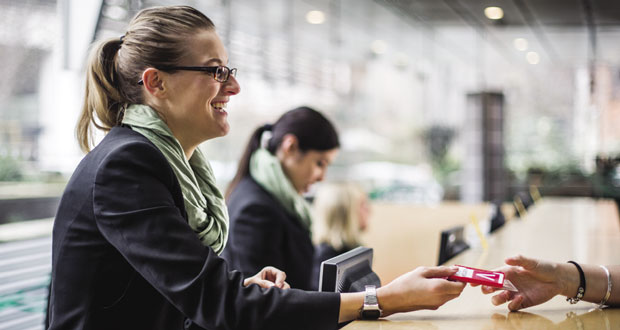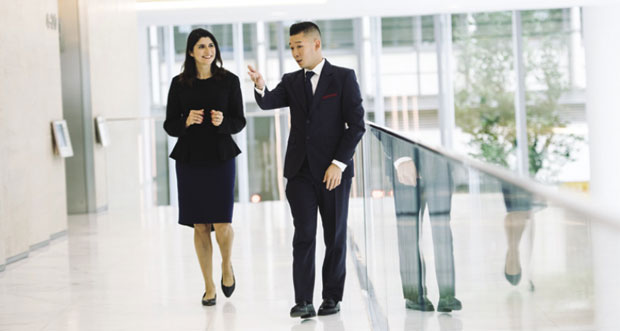Faced with so much disruption to traditional working patterns, what provisions can front of house specialists make to support new ways of welcoming people into the workplace? FMJ reports
Front of house has long been seen as reflecting the brand and ethos of an organisation, but now more than ever, is crucial in protecting building occupants. As organisations welcome staff and visitors back into buildings, ensuring safe and secure reception services mean that, as with other areas of FM during the pandemic, technology solutions are gaining credence. Research carried out by Swiss Post Solutions (SPS) found that half (50 per cent) of UK companies are planning to introduce digital technologies to help them maintain ‘front of house’ (FoH) services in the future. Does that mean that the traditional security guard and reception staff model is now redundant?
“No, I don’t think it is. In fact, I think it’s quite the opposite,” says Lauren Cooper of SmartSec Solutions. “While there is a demand for technology solutions such as virtual receptionists and an automated front of house check-in service, I personally can’t see any of our clients demanding that our receptionists work virtually, especially when the majority of our front of house and reception staff have continued to be physically present within empty buildings throughout the pandemic.
“We find that the presence of someone on front of house makes the office experience what it is. Occupants of the buildings get to know the staff on a personal footing, they ask each other about their weekends, and they have someone to approach if they have any questions or concerns. I’m not saying it’s not a good idea, but you simply don’t get that level of interaction virtually.”
Bianca Angelico, Chief DayMaker at Churchill Group’s brand-new front of house guest services offering, On Verve, believes that the interaction of people and technology is more a reflection on what was already happening with reception services prior to COVID-19.
“Pre-pandemic, the traditional role of a receptionist was moving away from being stationed behind a desk and transitioning to more of a host role; someone in front of the desk greeting guests and employees and being visibly more accessible. Now, I believe that we’ll see technology enabling people to check themselves in, elevating the host role in providing the human touch. This will include accompanying them to their meeting room or hot desking space, and ensuring everything is sorted and that the guest or employee feels safe and comfortable in the environment.”
Jess Pritchard, Head of Corporate Sector at Moneypenny agrees that front of house staff do not need to be physically front of house all the time, as the way organisations manage visitors and calls may need to change to suit hybrid working which could mean changes to ways space is assigned within a building.
She says: “I think it’s certain that FoH will morph into something more akin to a concierge service, as, with a hybrid model, employees are essentially visitors too. We know from recent research that 49 per cent of businesses already rely on reception or front-of-house teams to manage switchboards while juggling other duties so it seems likely this scope will increase further. Interestingly, 66 per cent of businesses feel their FoH teams answer switchboard calls to a higher standard when they have a more varied and interesting role, so there seems to be a real pay-off from expanding their scope.”
RE-ENTRY GUIDE
A myriad of reports suggest that workers are understandably nervous about returning to the office, which means front of house teams may play a huge role in helping smooth the transition for staff and visitors back into the workplace. According to Liz Cummins, Director, Perception, Mitie Security, by showing a friendly face and welcoming visitors, front of house staff will play a vital role here.
“The importance of providing reassurance and helping people orientate around the space or use technology should not be underestimated, particularly for employees who may have spent many months working from home.
“To support this, many of our front of house colleagues have attended emotional intelligence training to help them identify people that might be anxious about returning to their workplace. Using this training, they can then approach these visitors and explain to them the different COVID solutions that have been introduced, giving them some peace of mind that the business has done everything it can to keep them safe.”
Oliver Hiner, Director, Operations at Portico acknowledges the key role FoH have in helping ensure safety. He believes the use of stark safety posters and airport-style queueing in reception may feel very alien, which is where a FoH can help ensure everyone is compliant in a friendly, human way.
“We’re working with customers right now on ‘surprise and delight moments’ ahead of their employees’ return, creating new opportunities for FoH to engage with their people. This could be anything from a huge bunch of daffodils in reception in the spring, to an ice-cream truck handing out free ice creams on a hot day.”
Angelico points out that it’s important to differentiate too between employee and guest (visitor) requirements. Now that employees have more options where they work, employers need to make the workplace a destination, and the FoH team can be charged with welcoming employees back, greeting new starters, sharing safety updates, explaining workplace policies, introducing new team members to others and organising small get-togethers in the office.
She says: “These social aspects are essential, as one of the biggest drivers for employees to return to the workplace is for engagement and connection. FoH teams should be the eyes and ears around a building, checking in and getting feedback on how things are working and solving any pain points for clients.
“For visitors, it’s about sending pre-visitor information and giving them reassurance that the workplace is doing everything to keep them safe. A friendly welcome from a well-informed FoH team member can make the world of difference and help put a potentially anxious visitor at ease.”






